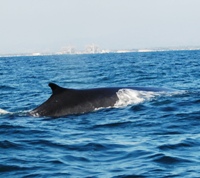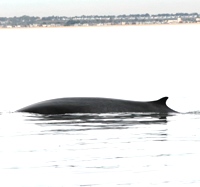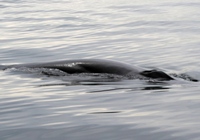(949) 675-0551 |
 |
DESCRIPTION: Fin whales are very slender and sleek and are the second largest whale next to the blue whale and may be almost equivalent to the blue whale in size in the northern hemisphere. Fin whales are also rorqual whales with dorsal fins and pleated throat grooves. They have a very unique coloration with brownish/black on top and on its sides and two lighter colored chevron patterns behind the blow holes. The underside of the body, fins and fluke are white. However the most unique part of their coloration is the dark grey and white coloration is split down the side of their head with grey on the left side and white on the right side and extends to the baleen coloration as well. The colors on the tongue however are reversed. This split coloration is thought to aid in feeding. |
| RANGE/HABITAT: Fin whales are also found world wide but their migration is not highly understood. It is thought that their migration occurs in open ocean to subtropical waters in the winter for mating and to Arctic and Antarctic waters in the summer to feed. There are some populations that might live year round in the Gulf of California and they have been recorded off the coast of California between November and January. | |
 |
BEHAVIOR: Fin whales feed on krill and small schooling fish. Because of the asymmetrical coloration on their jaw, it is thought that this aids in corralling the fish into bait balls and camouflaging themselves as they scoop up large mouthfuls of the fish. The can consume up to 2 tons of food a day. Also a baleen whale, they feed with the brush like structure called baleen that grows from the upper jaw inside their mouth. The baleen is formed from a series of overlapping plates each up to 30 inches long and 12 inches wide. Fin whales are one of the fastest whales in the ocean reaching speeds of up to 25 mph and have received the nickname “greyhounds of the sea”. While they are sounding or diving they keep their tail submerged and the fluke is rarely seen however despite their size they have been seen completely jumping out of the water. They are occasionally found in small groups of 3-7 individuals despite their size and feeding habits. They can be identified by their dorsal fin as it is larger than that of the blue whale and have a spout or blow that looks like an inverted cone. |
| MATING / BREEDING: Adults reach sexual maturity around 6-10 years old, sometimes before physical maturity. Gestation is about 1 year and they have their calves every 3-4 years. The babies are born at 14-20 feet in length and already weigh 2 tons. They are nursed with mother’s milk for the first 6-8 months and are eventually weaned and taught to feed on their own when they reach 30-40 feet. | |
 |
STATUS: During the early days of whaling, fin whales were almost entirely protected due to their range being in open ocean and deep water but in recent years within recent history with new technology and the decline of blue whale populations fin whales became the next target. As many as 30,000 fin whales were killed from 1935-1965 until they were placed under full protection from the International Whaling Commission in 1966. It is unknown what the populations were like before whaling but it is estimated that the numbers presently are around 40,000 in the northern hemisphere and 15-20,000 in the southern hemisphere. Like other whale species, the populations are still threatened today from human interference, pollution and global climate changes. |
For Reservations Call: |
||
(949) 675-0551 |
||
Newport Beach Whale Watching 309 Palm St. #A - Newport Beach CA. 92661 |
||
Copyright © 2001 Newport Landing
Whale Watching |
Whale Watching | Whale Watching Dana Point Visitors | Whale Watching Long Beach Visitors | Whale Watching Los Angeles Visitors
Whale Watching San Diego Visitors | Huntington Beach Whale Watching | Whale Watching Laguna Beach | Catalina Island Whale Watching